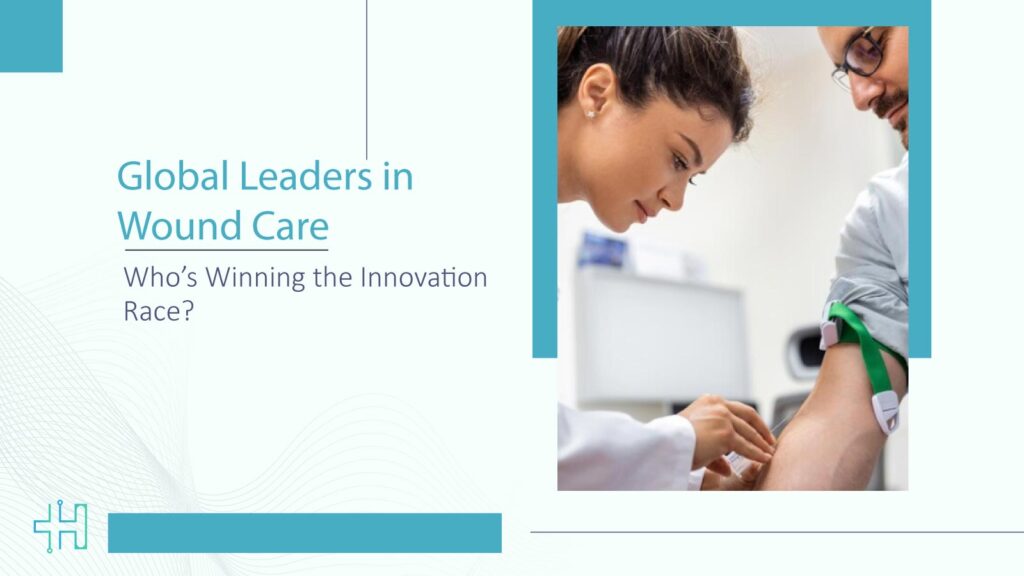Wound care can never be a glamorous career, perhaps, but in 2025, it is clear that this sector is quietly transforming healthcare worldwide. With an aging population and the chronically ill growing in numbers, demands for faster, smarter healing options have never been greater. So, who exactly is leading the way in this evolving picture?
This article takes a look at ten companies, veterans and newcomers alike, that are revolutionizing wound healing and enhancing lives worldwide.
1. Smith+Nephew: Merging Experience with Innovation
Smith+Nephew is no stranger to this game; they’ve been in business for more than a century. What’s interesting is how they’ve merged their extensive experience with today’s technology.
Their PICO™ single-use negative pressure device has made it easier and less burdensome for patients healing at home. They’re also looking at robotics and digital solutions to keep patients in communication with their care teams in real time.
2. 3M Health Care: Smarter Healing with Data
3M’s acquisition of KCI, the leader in the wound care industry, enabled them to create one of the most recognized devices on the market: the V.A.C.® Therapy. V.A.C. therapy creates negative pressure to activate healing, but 3M’s more recent actions are centered around smart data.
They’re creating AI-driven imaging technology that allows clinicians to track wounds remotely and adjust treatments in real-time. That kind of technology is revolutionizing how patients and practitioners manage wounds.
3. Mölnlycke Health Care: Patient Comfort and Care
One of the ways that Mölnlycke stands out is that it focuses so much on the comfort of its patients. Not only are their Mepilex® dressings kind to the skin, but they are also phenomenally effective.
However, it’s not all about the product; they are also leaders when it comes to sustainability, trying to make wound care greener. This marriage of patient and environmental concern is a win-win in the healthcare world today.
4. Convatec: Addressing Chronic Wounds Head-On
Diabetic foot ulcers are a real challenge, and Convatec has made itself a front-runner in addressing this through dressings like AQUACEL® Ag+ Hydrofiber® that fight infection and support healing. They’re also entering the digital health space to give clinicians better insights and help with individualizing care, which patients with long-term wounds need.
Karim Bitar, CEO of Convatec, emphasized the importance of regulatory support, stating: “Regulatory approval and NHS reimbursement are crucial to motivate continued research, development, and manufacturing investments in the UK.”
5. Coloplast: Streamlining Wound Care and Effectiveness
Coloplast combines science and usability. Their dressings, like Biatain Silicone, bring advanced materials together with a focus on the user experience. And their Wound Genix platform lets healthcare teams track wound healing online.
What’s remarkable is how they’re bringing care out of hospitals and into homes, delivering high-quality wound management wherever it’s needed.
6. Medline Industries: The Unsung Hero
Medline might never be in the news, but its presence is huge. They carry a huge line of wound care products and take considerable time educating healthcare professionals. Along with this comes the guarantee that quality care makes its way to the patients in hospitals, nursing homes, and home care.
Their adjustable kits make the job of wound management for caregivers less burdensome, especially in cases where resources are scarce.
7. Swift Medical: The Power of Your Smartphone
One of the highly awaited new players, Swift Medical is leveraging phone cameras and AI so that clinicians can measure wounds remotely with precision. That keeps patients at home but still allows them to get expert care, saving time and reducing hospital visits a real telemedicine breakthrough.
8. Tissue Analytics: Imaging at Your Fingertips
Tissue Analytics provides a straightforward app that uses AI to scan and interpret images of the wound. Software eliminates guesswork by providing objective measures of wound size and healing. It is especially valuable in busy clinics where time is crucial, streamlining wound exams and accuracy.
9. Sanara MedTech: Healing from the Inside Out
Sanara MedTech stands out from the pack in its application of regenerative medicine and digital monitoring. Its use of biologic therapies, including amniotic membrane products, facilitates tissue regeneration. Combined with smart tracking platforms, they give clinicians an unparalleled view of the healing process.
10. NanoVibronix: Healing with Sound Waves
Last, NanoVibronix is pioneering wearable ultrasound devices that initiate wound healing using low-frequency sound waves. This non-surgical treatment is helping patients who have had chronic, recalcitrant wounds that will not heal with conventional treatments.
What Holds These Innovators Together?
Though each of these companies has its specialties, all of them have several things in common:
- A commitment to improving life and making it easier for patients.
- The use of technology to provide wiser, faster healing.
- People are making efforts to bring better care to high-tech settings as well as low-resource environments.
- A commitment to education and sustainability, ensuring innovations stand the test of time.
Why This Matters Today
As a greater number of individuals live longer and deal with chronic illnesses, wounds that would normally quickly recover naturally now have the potential to become costly and complicated. Smarter, faster wound care delivers good medicine, saves costs, and alleviates torment.
Health care is shifting towards paying for outcomes, rather than volume, so treatments that hasten healing and reduce hospitalization are more and more valuable. These innovators are not only creating products, but also transforming the way wound care functions within the broader health environment.
A report pointed out that negative pressure wound therapy is anticipated to be the most profitable segment of the market for wound care, fueled by its ability to ensure healing at a faster pace
Looking Ahead
As the science of wound care advances, the competition to innovate will only intensify. Veterans such as Smith+Nephew and 3M are still major players, but agile startups such as Swift Medical and NanoVibronix are demonstrating that innovative thinking can make a dramatic impact very fast.
For healthcare executives, that means now is the best time ever to invest in patient-centric, data-driven, and scalable wound care technologies.
Healing isn’t just about bandages and creams anymore. It’s about smart, integrated care that connects with patients where they are.
FAQs
1. Who are the top global innovators in wound care technology in 2025?
In 2025, the top global wound care innovators include Smith+Nephew, Mölnlycke Health Care, 3M Health Care, Convatec, and Coloplast, each leading in specialized areas like advanced wound dressings, negative pressure wound therapy, smart sensors, and regenerative solutions.
2. How are aging populations influencing wound care innovation in the U.S.?
The U.S. Census projects that by 2034, adults aged 65+ will outnumber children under 18. This shift is increasing the prevalence of chronic wounds like pressure ulcers and venous leg ulcers.
3. What role is AI playing in modern wound care solutions?
AI enables automated wound assessment, builds predictive healing models, and personalizes treatment plans to transform wound care. Tools like Swift Medical and Tissue Analytics help clinicians track wound progression with high precision, reduce errors, and enable earlier interventions.
4. Why is Negative Pressure Wound Therapy (NPWT) considered a growth segment in 2025?
NPWT remains a high-growth area due to its proven efficacy in accelerating healing, especially for complex wounds like diabetic foot ulcers and post-surgical incisions.
5. What should U.S. healthtech decision-makers prioritize when evaluating wound care technologies?
Decision-makers should focus on clinical efficacy, scalability, cost-effectiveness, and integration with digital health ecosystems. Solutions that offer value-based care benefits, like reduced healing time, fewer hospital visits, and better patient engagement, are particularly attractive.
To participate in our interviews, please write to our HealthTech Media Room at sudipto@intentamplify.com






